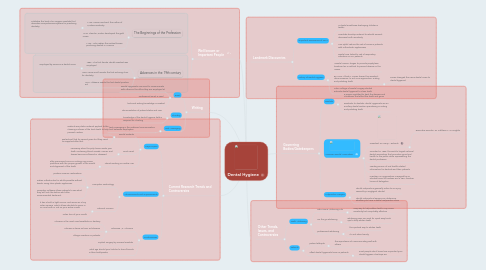
1. Current Research Trends and Controversies
1.1. Major Topics
1.1.1. Dental Sealants
1.1.1.1. sealants are plastic material applied to the chewing surfaces of the back teeth to help prevent cavities
1.1.1.2. sealants will last for several years but they need to reapplied after that
1.1.2. Root Canal
1.1.2.1. necessary when the pulp tissue inside your teeth containing blood vessels, nerves, and tissues become inflamed or diseased
1.1.3. Thumb sucking or Pacifier Use
1.1.3.1. after permanent come in sucking may cause problems with the proper growth of the mouth and alignment of the teeth
1.2. Advancements and Improvements
1.2.1. Computer Technology
1.2.1.1. produce ceramic restorations
1.2.1.2. makes orthodontics for adults possible without bands, suing clear plastic appliances
1.2.1.3. computer software allows patients to see what they will look like before and after recommended treatment
1.2.2. Intraoral Camera
1.2.2.1. it has a built in light source, and serves as a tiny video camera which allows dentists to zoom in on one tooth or out on your entire mouth
1.2.2.2. video tour of your mouth
1.3. Controversies
1.3.1. Lidocaine Vs. Articaine
1.3.1.1. Articaine is the most used anesthetic in dentisry
1.3.1.2. Articaine is twice as toxic as lidocaine
1.3.1.3. allergic reactions in patients
1.3.2. Implant Surgery by General Dentists
1.3.3. What age should your kids be to have fluoride in their toothpaste?
2. Well known or Important People
2.1. The Beginnings of the Profession
2.1.1. 1723- Pierre Fauchard, the Father of Modern Dentistry.
2.1.1.1. Publishes the book The Surgeon Dentists that describes comprehensive system for practicing dentistry
2.1.2. 1746- Claude Mouton developed the gold crown
2.1.3. 1760 - John Baker, the earliest known practicing dentist in America
2.2. Advances in the 19th century
2.2.1. 1885 - The first female dental assistant was employed
2.2.1.1. employed by Fones as a dental nurse
2.2.2. 1832 James Snell invents the first reclining chair for dentistry
2.2.3. 1841 Alabama enacts the first dental practice act
3. Writing
3.1. Email
3.1.1. Dental Hygienists use email to communicate with others in the office they are employed at
3.1.2. Professional email is used
3.1.3. technical writing knowledge is needed
3.2. Charting
3.2.1. documentation of patient status and care
3.2.2. knowledge of the dental hygiene field is required for charting
3.3. Text Messaging
3.3.1. text messaging is the preferred communication tool between employees
4. Governing Bodies/Gatekeepers
4.1. Dentists
4.1.1. a person qualified to treat the disease and conditions that affect the teeth and gums
4.1.2. assistants to dentists, dental Hygienists are an ancillary dental worker specializing in scaling and polishing teeth
4.2. American Dental Association
4.2.1. President: Dr. Gary L. Roberts
4.2.1.1. Executive Director: Dr. Kathleen T. O'Loughlin
4.2.2. Founded in 1859, the world's largest national dental association that promotes good oral health to the public while representing the dental profession
4.2.3. Leading source of oral health related information for dentists and their patients
4.2.4. member run organization managed by an elected board of trustees and a 480- member house of delegates
4.3. Malpractice Lawyers
4.3.1. dental malpractice generally refers to an injury caused by a negligent dentist
4.3.2. dental malpractice lawyers can determine whether you have a dental malpractice claim
5. Landmark Discoveries
5.1. Important Discoveries of 2015
5.1.1. Is dental anesthesia destroying children's teeth?
5.1.2. Scientists develop material to rebuild enamel, decrease tooth sensitivity
5.1.3. Can xylitol reduce the risk of caries in patients with orthodontic appliances?
5.1.4. Dental care linked to risk of respiratory infections in ICU patients
5.2. History of Dental Hygiene
5.2.1. “Dental nurses” began to provide prophylaxis treatment as a method to prevent disease in the 1880s.
5.2.2. By 1906, Alfred C. Fones trained his assistant, Irene Newman, to act as an apprentice, scaling and polishing teeth
5.2.2.1. Fones changed the name dental nurse to dental hygienist
5.2.3. Ohio College of Dental Surgery started educate dental hygienist to clean teeth
6. Other Trends, Issues, and Controversies
6.1. Teeth Whitening
6.1.1. Take Home Whitening Kits
6.1.1.1. easy way to help whiten teeth, may cause sensitivity but completely effective
6.1.2. On the go whitening
6.1.2.1. whitening pens are used for quick easy touch ups to help whiten teeth
6.1.3. professional whitening
6.1.3.1. the quickest way to whiten teeth
6.1.3.2. It's not about vanity
6.2. Patients
6.2.1. patient ettiqute
6.2.1.1. the importance of communicating well with others
6.2.2. affect dental hygienists have on patients
6.2.2.1. most people don't know how important your dental hygiene checkups are
